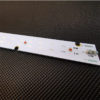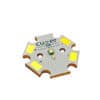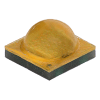Led Technology
Precision Dimming Design Guide
Cree Application Note: CLD-AP268 REV 1

INTRODUCTION
When operated in parallel strings, as is common in many linear LED designs, LEDs driven at relatively low currents (e.g., less than 20 mA for 3-V mid-power LEDs) will exhibit unacceptable light output and hue variations across the strings. These light output variations are caused by normal production variations in characteristics of LEDs and can be reduced substantially with proper system design. Lighting designers, specifiers, architects and end users have observed this inconsistency issue while dimming in many common linear-style LED designs, including cove accent lighting, wall texture graze lighting, indirect lighting and in some recessed linear general illumination. Other LED manufacturers address LED inconsistency by sorting the forward voltage of the LEDs twice: once at the binning current and again at a lower current. This approach results in additional voltage bins that may be difficult to manage in production.
PRECISION DIMMING DELIVERS CONSISTENT DIMMING
Cree LED tapped into our extensive LED performance and manufacturing knowledge to address this issue of inconsistent LED dimming. Our engineering team has developed a new method to bring consistency for low-input intensity and color performance-critical applications. Industry standard 3-dimensional binning (chromaticity, voltage and flux) is greatly improved by the introduction of a simple fourth dimension that Cree LED calls Precision Dimming. Precision Dimming provides the easiest solution to manufacturers of no-compromise, specification-grade lighting. There are only four total Precision Dimming bins: J, K, L & M. In addition, each CCT & CRI combination of an LED with Precision Dimming will only ever have two Precision Dimming bins.
PRECISION DIMMING CONTROLS FOR TM-30 METRICS
Precision Dimming also gives more consistent fixture-to-fixture scores in TM-30 specifications at all operating currents. You can have confidence that each fixture will consistently meet the same specifications as your first if you follow the guidelines in this document. In our testing, the range of Rf and Rg measured on a 4×5 array was narrowed to about 1/3rd of the range in arrays not using Precision Dimming. Note that these values are relative and recorded for one CCT/CRI combination. The trend and range may change in other situations.

Figure 1: TM-30 metrics Rf and Rg are more consistent between fixtures when using only one or two Precision Dimming bins. Compared to un-binned LEDs (the “All” segment above), the range of fixture measurements possible from building with a single bin is narrowed to roughly 1/3rd of the original
range.
CASE STUDY: USING PRECISION DIMMING BINNING
Three test boards were built using Precision Dimming bins J, K, L and M (the full range of bins) in different configurations. Please note that
only two consecutive bins are used in each CCT/CRI combination, making it even easier for you to design and build.
Each board had the same electrical configuration: 4 parallel strings of 5 LEDs each. Each string of 5 LEDs was constructed from only one
bin but the strings of each bin were mixed in parallel to simulate what can happen if boards are built without controlling for binning, or
incorrectly building with binning.
• Board 1: J-K-L-M (Worst case of mixing a full range of bins)
• Board 2: J-J-M-M (Worst case of mixing highest and lowest bins)
• Board 3: K-K-K-K (All strings use single Precision Dimming bin)
Below are false color intensity images, true color images and line graphs of individual component intensity values for 3500 K LEDs



ARRAY DESIGN GUIDELINES USING PRECISION DIMMING
Your manufacturing process can effectively use both available Precision Dimming bins to reduce or eliminate inconsistent dimming with
the right planning.
1. Do not use dissimilar Precision Dimming bins in parallel strings when each string is a single bin.
2. Do use a single Precision Dimming bin and CCT/CRI bin for an entire board build.
3. If mixing bins, only mix equal numbers of each Precision Dimming bin and CCT/CRI bin in each parallel string.
For illustration, here is an example circuit (4 parallel strings of 5 LEDs) in configurations that do and do not build with Precision Dimming
properly. Assume each bin (J, K, L, M) has a numerical value where J=4, K=3, L=2, M=1. These bin codes can be found on the label of
the received LED reel. For the best outcome, every parallel string’s Precision Dimming bins should sum to the same total number. This
assumes the same number of LEDs per string, i.e., 1+1+1 does not equal 1+2.
If you have a more complicated design that is not covered below, please reach out to your Cree LED application engineer for guidance




Industry experts have suggested that a 10% delta in hue and 20% delta in intensity is the maximum acceptable LED-to-LED performance
variation. Precision Dimming is the easiest way to stay well within these acceptability targets and enables our specification-grade
customers to build products that produce no-compromise illumination for their demanding customers.

















